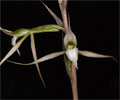|
|
|
|
 |
Email Address Recovery or Password Reset |
Use our Change Password page, and you can set a new password, or if you don't remember which email address you
registered with, the same page may be able to suggest it based on another you enter.
|
|
|
|
|
| |
Flasks of
Eltroplectris calcarata 'MC7272' × 'MC7270' |
|
| |
|
|
| |
| Number: |
TN8346 |
| Name: |
Eltroplectris calcarata 'MC7272' × 'MC7270'
|
| Type: |
outcross (What's that?) |
|
Seed Donor: |
Troy C. Meyers
|
|
Click to Enlarge

Pod Parent Flower |
Click to Enlarge

Pod Parent Blooming Plant |
Click to Enlarge

Pollen Parent Flower |
|
|
|
| |
Comments: Pod parent plant: One of the offspring from our TN6307 effort of 2008.
Pollen parent plant: One of the offspring from our TN6942 effort of 2010.
For additional origin/habitat information supplied courtesy of
Charles and Margaret Baker, see further below, near the bottom of this page.
|
Temperatures we attempt to use in the lab & greenhouse:
| For Species: |
|
Spring, Summer, Autumn: days average 87°F, nights 76°F; best fit is Warm 90-70°F
(Source:
Baker's Web OSC) |
| For Species: |
|
Winter: days average 87°F, nights 76°F; best fit is Warm 90-70°F
(Source:
Baker's Web OSC) |
|
About the name...
| Etymology of |
calcarata |
|
From Latin "calcaratus" spurred, having a spur.
(Source:
Mayr & Schmucker 1998) |
| Etymology of |
Eltroplectris |
|
From latinized Greek "plektron" spur. The meaning of "eltro" is not clear.
(Source:
Mayr & Schmucker 1998) |
| Pronunciation of |
Eltroplectris |
|
el-troe-PLEK-tris
(Source:
Hawkes 1978) |
|
If you would like to direct someone to this web page, please copy and paste this URL into your email:
http://troymeyers.com/d?018346
| Flask Information |
| Availability: |
We have sold all of the flasks for this item. |
| You should: |
Consider getting individual plants or compots instead of a flask.
You can place a "Notify Flask Recipients" Request, and either we or a flask recipient may contact you when plants are available.
You may also place a "Notify Retries" Request, and if an identical pollination (the same parents) is done again, we'll let you know.
You may reserve a flask, but it's very unlikely you'll get one ...this could only happen if we found a flask that we didn't know we had. |
| Yield Estimate: |
356 plants (based on flask surveys done 10/05/2017 through 06/25/2018)
|
| Plantlet Sizes: |
From many flasks 10 - 80 mm plants (based on flask surveys done 03/21/2018 through 06/29/2019)
From one most recently surveyed flask 40 - 80 mm (06/29/2019)
|
|
You might also want to:
|
View the seed assay for this item.
View items of the same species.
View items of the same genus.
|
| Ordering Information |
| You are not currently logged in. |
|
You must be a registered user and be logged in to reserve a flask or place a notification request. Please log in:
|
|
 |
Email Address Recovery or Password Reset |
Use our Change Password page, and you can set a new password, or if you don't remember which email address you
registered with, the same page may be able to suggest it based on another you enter.
|
|
|
|
|
|
|
|
| |
The origin/habitat information below is supplied courtesy of Charles and Margaret Baker
The following information is based on the name of the plant provided by the donor, and assumes that the name is correct. If the plant has been misidentified, then the following information may not be correct.
This text is copyrighted by the Bakers and may not be reproduced without permission.
ORIGIN/HABITAT: This often-named terrestrial orchid is found from southern
Florida through the Caribbean to South America in Brazil and Colombia.
Plants in Florida were found in Dade County in a dense hammock in 1905 and
Highlands County in 1936 where they were growing in a low, moist hammock.
These swampy forests have given way to progress, and it is not known
whether or not plants still survive in out-of-the-way locations in
Florida. Plants are said to be common in the Bahama Islands where they
grow in rather dense coppices, reportedly blooming January to March. In
Puerto Rico this orchid is uncommon but is known from the western part of
the island where it grows in thick humus in the shade of moist to wet
montane forests at 1000-2950 ft. (300-900 m).
More about this information and the Bakers...
|
|
|
| |
|
|
|